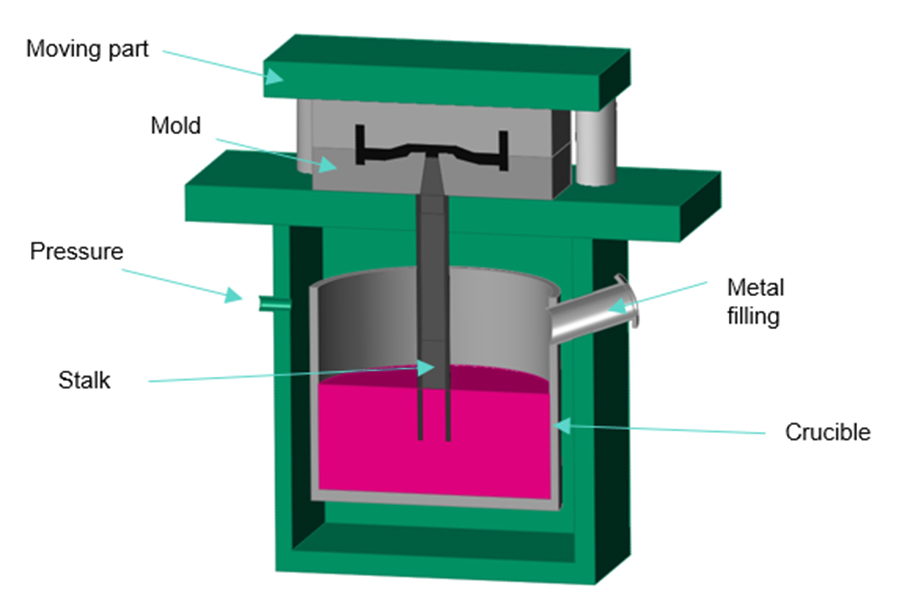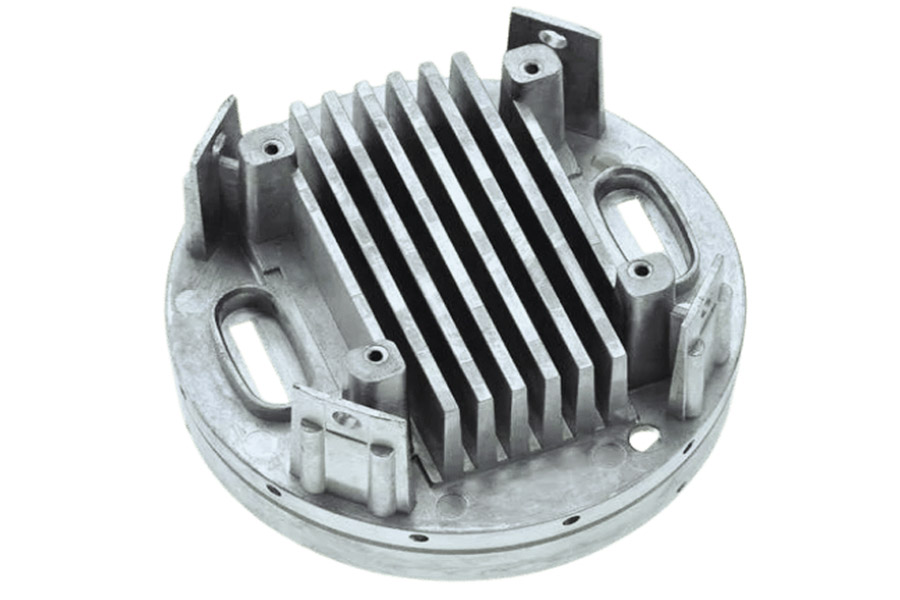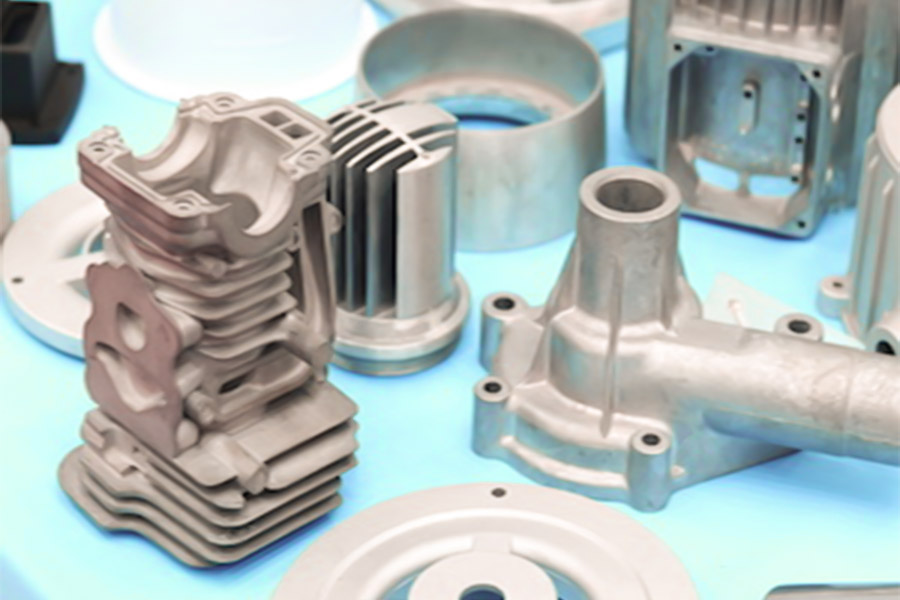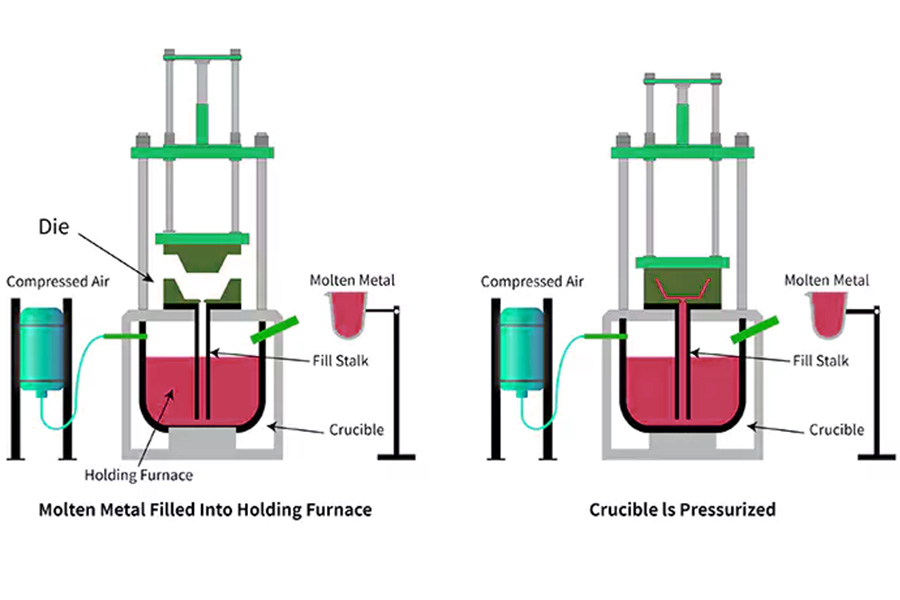Low pressure casting is a high-precision, high-efficiency metal manufacturing processsuitable for industrial, commercial and consumer products. Die casting molds have a long service life, are suitable for manufacturing complex metal parts, and are of great value in mass production.
Several metals are suitable as low pressure casting materials. The main low pressure casting materials are aluminum, magnesium and zinc alloys, each of which has its own advantages and suitable uses. This article introduces the bestlow pressure casting materials, listing their respective advantages and common applications in manufacturing.
What is Low Pressure Casting?
Low pressure casting is a metal forming processthat uses gas pressure as a driving force to push molten metal to fill the mold cavity smoothly and evenly, and complete the solidification process under controlled environmental conditions. This technology is usually carried out in a sealed casting system. By precisely regulating the size and time of gas pressure, it can achieve fine control of the filling speed and solidification process of molten metal.
Low pressure casting can not only effectively avoid defects such as turbulence, oxidation and pores caused by molten metal during mold filling, but also improve the density, mechanical properties and surface quality of castings. Therefore,it is widely used in aerospace, automobile manufacturing, power equipment and precision instruments. It has a wide range of applications in high-end manufacturing fields.

What Materials Are Used in Low Pressure Casting?
Low pressure casting mainly uses the following types of materials:
1. Casting material
Casting material is the substance used to make casting patterns, andlow pressure casting can use a variety of casting materialsto adapt to the needs of different castings. Common mould materials include:
- Molding sand:a commonly usedcasting materialwith good formability and air permeability, suitable for making castings with complex shapes.
- Resin sand:a mixture of resin and sand particles, with high strength and hardness, suitable for making high-precision and high-quality castings.
- Metal:such ascopper, iron, aluminum and other metal materials, can be used to make metal mold castings, with high thermal conductivity and good wear resistance.
- Ceramics:With high hardness and high temperature resistance, it is suitable for manufacturing high temperature alloy castings.
- Graphite:With good self-lubrication and high temperature resistance, it is suitable for manufacturing castings that require self-lubrication or high temperature resistance.
- Gypsum:Easy to shape and demold, suitable for manufacturing small and complex shaped castings.
2. Mold materials
Mold material is the material used to make low pressure casting mold.Low pressure casting moldneeds to withstand the erosion and pressure of high-temperature metal liquid, so the selection of mold material is very important. Common mold materials include:
- Cast iron:low cost, easy to process, but easy to deformation, relatively short life. Suitable formanufacturing castingswith low mold life requirements.
- Alloy steel:with high hardness and strength, good wear resistance, suitable for the manufacture of high precision and high quality casting mold.
- Carented carbide:with high hardness and high wear resistance, suitable for manufacturing molds requiring high scouring force and high pressure.
- Tungsten handle:with extremely high hardness and wear resistance, but the cost is high, suitable for the manufacture of mold life and wear resistance requirements.
- Aluminum alloy:small density, high strength, good rigidity, good thermal conductivity, light quality, easy tomachining and welding, can be suitable for the manufacture of large and medium-sized molds.

How to choose suitable low pressure casting materials?
Whenselecting suitable low pressure casting materials, the following key factors should be considered:
- Casting performance requirements:Materials are selected based on the required mechanical properties (such as strength, hardness, toughness, etc.) and chemical properties (such as corrosion resistance, heat resistance, etc.) of the casting. Make sure the selected material can meet the usage environment and functional requirements of the casting.
- Processing performance:Consider the casting properties of the material, including fluidity, shrinkage, hot cracking tendency, etc. Easily cast materials reduce defects and improve casting quality.
- Cost-Effectiveness:Evaluate the cost of different materials, including raw material prices, processing fees, and subsequent processing costs. Choose cost-effective materials to ensure economic benefits.
- Recyclability:Consider the environmental protection and recyclability of materials to comply with current environmental protection trends and policy requirements.
- Production experience and technology:Combined with existing production experience and technical level, select materials that are easy to operate and control to reduce production difficulty and risks.
What are the advantages of low pressure casting?
Low pressure casting has several significant advantages:
| Advantages | Description |
| High purity of castings | Since molten slag generally floats on the surface of the molten metal, low pressure casting fills the mold through the molten metal in the lower part of the crucible, which avoids the possibility of molten slag entering the mold cavity, thus improving the purity of the castings. |
| Stable filling | The molten metal fills the mold smoothly under pressure, which reduces the tumbling, impact and splashing of the molten metal during mold filling, reduces the formation of oxide slag, and improves the quality of the casting. |
| The casting has a dense structure | The casting crystallizes and solidifies under pressure and can be fully fed, making the casting a dense structure and high mechanical properties. |
| High utilization rate of molten metal | Generally, no riser is needed, and the unsolidified metal in the riser tube can be returned to the crucible for repeated use, greatly increasing the yield of molten metal, usually up to more than 90%. |
| Easy to automate | Low pressure casting is easy to operate, has good working conditions, high production efficiency, and is easy to realize mechanized and automated production. |
| Wide scope of application | Low pressure casting can be used to cast various non-ferrous alloys, such as aluminum alloys, magnesium alloys, etc., as well as cast iron and cast steel. It is especially suitable for casting castings with complex shapes and high performance and quality requirements. |
What are the disadvantages of low pressure casting?
Thedisadvantages of low pressure castingmainly include the following points:
| Disadvantages | Description |
| Relatively low production efficiency | Compared with gravity die casting, low-pressure casting has lower production efficiency, mainly because its casting cycle is longer and the solidification speed is relatively slow due to higher mold temperature. |
| High equipment costs | The equipment required for low pressure casting is relatively complex, including main engine, hydraulic system, holding furnace, liquid surface pressurization device, electrical control system and mold cooling system, etc., so the equipment investment is relatively large. |
| High management requirements | In order to maintain directional solidification and melt fluidity, low pressure casting requires comprehensive and strict management, including precise control of process parameters such as temperature and pressure, which increases the difficulty and cost of management. |
| The life of the riser tube is limited | the riser tube is easily corroded and scrapped during long-term use. Especially when producing aluminum alloy castings, the crucible and riser tube are in long-term contact with molten metal, which is more likely to shorten the life of the riser tube. |
What equipment is commonly used in low pressure casting?
The core equipment commonly used in low pressure casting is thelow pressure casting machine, but the entire low pressure casting system also contains some other key components and equipment, including:
- Low pressure casting machine:It is the main equipment of thelow pressure casting processand is used to control the filling and solidification process of molten metal. Usually includes the main engine, hydraulic system, electrical control system and other parts.
- Insulation furnace:used to store and insulate molten metal to ensure that the molten metal maintains a stable temperature during the casting process. Common types of holding furnaces include graphite crucible holding furnaces and refractory lined holding furnaces.
- Lift pipe:a metal tube connecting the holding furnace and the mold, used to introduce molten metal from the holding furnace into the mold cavity. The material and size of the riser pipe need to be selected according to the type of metal cast and the size of the casting.
- Mold:Tooling equipment used to form the shape of a casting. The design of the mold needs to consider factors such as the fluidity of the molten metal and solidification shrinkage to ensure the quality of the casting.
- Liquid surface pressurizing device:used to apply pressure to the molten metal to fill the mold cavity from bottom to top. Pressurizing devices usually include air pumps, pressure gauges, valves and other components.
- Cooling system:used to cool the mold to accelerate the solidification process of the casting. The cooling system usually includes cooling water pipes, water pumps, radiators and other equipment.
- Alloy liquid treatment equipment:used for degassing and slag removal of molten metal to improve the quality of castings. Common alloy liquid treatment equipment includes rotating degasser, stationary slag remover, etc.
- Slagging equipment:used to remove surface scum and oxides before pouring molten metal. The slag removal equipment can be operated manually or with automated equipment.
- Detection and measurement equipment:used to detect and measure parameters such as temperature, pressure, and molten metal composition during the casting process. Common detection and measurement equipment include thermometers, pressure gauges, spectrum analyzers, etc.

What types of castings are suitable for low pressure casting?
Thetypes of castingssuitable for low pressure casting mainly include the following categories:
- Non-ferrous alloy castings:Low pressure casting is particularly suitable for the production of non-ferrous alloy castings such as aluminum alloys and magnesium alloys. This type of casting usually requires a dense structure, good mechanical properties, and high surface quality.
- Complex-shaped castings:Due to the good filling conditions of low pressure casting, castings with complex shapes can be cast. This type of casting is often difficult to produce by other casting methods, andlow pressure casting can meet its requirements.
- Thin-walled castings:Low pressure casting can produce thin-walled castings because the molten metal fills the mold under pressure and can better fill the mold cavity and avoid defects such as pores and inclusions.
- Castings with high quality requirements:Castings cast by low pressure casting usually have high mechanical properties, pressure resistance and leakage resistance, so they are suitable for the production of castings with high quality requirements, such as cylinder blocks, cylinder heads, pistons and other automotive parts. as well as large marine propellers and large ductile iron crankshafts, etc.
How Does Low Pressure Casting Differ from High Pressure Casting?
Low pressure casting and high pressure casting are two different metal casting processes, and they differ significantly in many aspects. The following table compares the main differences between the two casting processes:
| Project | Low pressure casting | High pressure casting |
|---|---|---|
| Driving force | Gas pressure (barometric pressure) | Hydraulic cylinder drive (hydraulic) |
| Pressure range | Generally, it is low, and the air pressure is 0~2Kg/cm² | High, use oil pressure |
| Filling speed | Slower, which helps the gas to expel out | Faster, improve production efficiency |
| Casting quality | High quality, high precision, dense tissue | The surface quality is good, and there may be pores inside |
| Casting type | Complex shapes, high precision requirements | Large-scale, mass-produced for thin-walled castings |
| Fields of application | Auto parts, aerospace parts, etc | Home appliances, hardware products, etc |
| Equipment costs | Relatively low | The higher the mold manufacturing cycle is longer |
| Productivity | In general, the coagulation rate is slower | High, suitable for mass production |
| Mould material | Molding sand, resin sand, metal, ceramic, etc | It depends on your specific needs |
| Advantage | The structure is dense, the mechanical properties are good, and it is easy to be mechanized and automated | High production efficiency, suitable for thin-walled castings |
| Disadvantages | Lower productivity and long casting cycles | There may be pores inside, and the casting is not dense |
What are the stages in the history of low pressure casting?
Thehistory of low pressure castingcan be traced back to the early 20th century and has gone through several stages of development. Here is a brief overview of the history of low pressure casting:
- Origin and early experiments:At the beginning of the 20th century, the prototype of low pressure casting began to appear. In the 1920s, France and Germany began to try to apply the low pressure casting method to aluminum alloy casting. However, it was still in the experimental and primitive accumulation stage, the technical conditions were relatively backward, and the application of aluminum alloys was not widespread, so the low pressure casting process was not widely used.
- Small-scale application:In 1945, after the end of World War II,low pressure casting began to be used on a small scalein the UK, mainly for the production of civilian industrial parts such as rainwater pipes and beer containers. Since then, low pressure casting technology has also begun to be applied in electrical, textile machinery and other industries.
- Wide application and development of the automobile industry:In the 1950s,low pressure casting technologybegan to attract the attention of the global automobile industry. In 1956, West Germany's K.S. Company began to apply low pressure casting technology to produce air-cooled engine cylinder heads for small cars. In 1958, Americans applied low pressure casting to the casting of automotive engine parts, such as cylinder heads, cases, gear boxes, etc. This marked the beginning of widespread application of low pressure casting and caused great repercussions in the automotive industry.
- Development in China:In the late 1950s,low pressure casting methodwas introduced to China. In the 1960s, China began to research and introduce low-pressure casting equipment. The production of air-cooled cylinder heads for light vehicles became the beginning of the practical application of low pressure casting in China. In 1961, China began to use low pressure casting technology to produce auto parts. Since then, low pressure casting technology has been widely used in China's automotive industry and has gradually established its solid position in light alloy castings.
- Modern applications and developments:With the development of automobile lightweighting and the increased demand for high-performance parts, low pressure casting technology has been further developed. Modern low pressure casting technology can produce more complex and higher-quality castings and is widely used in automotive, aerospace and other fields.

Where is low pressure casting Used?
Typical applications of low pressure castingcover a variety of fields such as automobiles, aerospace and consumer products. The following is a detailed summary of these applications:
1.Automobile manufacturing:
In the automotive industry,low pressure casting is widely used to produce key parts such as wheels, engine parts (such as cylinder blocks, cylinder heads), suspension parts, etc. These parts require high strength, high precision and good corrosion resistance. Low-pressure casting technology can meet these requirements and improve the reliability and durability of automobiles.
2.Aerospace:
In the field of aerospace,low pressure casting is used to manufacture lightweight structural parts such as aircraft engine blades, turbine parts, etc. These parts need to withstand the harsh environment of high temperature, high pressure and high speed operation. Low pressure casting technology can provide materials with high strength, high toughness and heat resistance to ensure the safety and performance of aerospace vehicles.
3.Consumer goods manufacturing:
In the consumer goods field,low pressure casting is used to produce high quality electricaland electronic product housings, kitchenware, furniture accessories, etc. These products require exquisite appearance and good durability. Low pressure casting technology can provide high precision, high-gloss and corrosion-resistant materials to meet consumers' demand for product quality.
4.Other industrial fields:
Low pressure casting is also used in other industrial fields, such as shipbuilding, heavy machinery manufacturing, etc. In these fields, low pressure casting technology can produce large, complex shapes and high-performance castings to meet the requirements of industrial equipment for high strength, high precision and long life.
What are the reasons for choosing LS as your partner?
LS Steel is certainly one of China’s high aluminumand zinc die casting manufacturing service suppliers. Along with casting, we additionally present prototyping, tooling, machining, and floor ending providers. We use essentially the most superior expertise for die-casting manufacturing. OurCNC machining serviceruns with one of the best expertise and a decade-long skilled engineers and employees. We provide one of the best cost-saving and technical machining design and manufacturing solutions you may ask for. Here’s a record of our CNC machining capabilities:
- Our CNC milling store incorporates5-axis CNC machinesthat are extremely exact. These machines are able to offering tolerance as much as 0.005mm.
- We now have speedy CNC fixture expertise that ensures quicker machining and on-time supply for our purchasers.
- Our machining service is just not just for casting parts but additionally for a lot of sorts of plastics and chrome steel parts.
- From superior CNC lathes and EDM machines to floor grinders and wire slicing machines, we’ve got every little thing you want for machining in our machine store.
The machined casting process is just not the ultimate job for a casting half. Floor ending can also be an vital a part of casting manufacturing. Holding that in thoughts, we offer surface finishing providers like anodizing, powder coating, chrome plating, moist portray, and many others. So you may see thatLS Steel suppliesthe whole resolution to die casting manufacturing. We offer providers in China and likewise internationally. Contact us to have one of the best die casting manufacturing service from China.
FAQs
1.What materials are mainly used as casting materials in low pressure casting?
There are many choices for low pressure casting mold materials, including but not limited to molding sand, resin sand, metal, ceramics, graphite, and gypsum. The choice of different materials depends on the precision, complexity and required properties of the casting. For example, high-precision castings usually use metal molds, castings with complex internal structures may use sand cores, and castings with complex structures and high precision requirements may use investment shell molds.
2.What materials are low pressure casting mainly suitable for?
Low pressure casting is mainly suitable for castingsof non-ferrous alloys, especially light alloys such as aluminum alloys and magnesium alloys. These alloys offer good formability, corrosion resistance, light weight and high strength, making them ideal forlow pressure casting processes. In addition, low pressure casting can also be used to produce copper castings, iron castings and steel castings with higher melting points, but relatively speaking, its application in light alloy casting is more extensive.
3.What are the characteristics of low pressure casting castings?
Low pressure casting castings have the characteristics of dense structure, good surface quality, and high process yield. Due to the use of anti-gravity casting technology, this technology can cast thin-walled and complex castings that are difficult to form, and is suitable for the production of medium- to thin-walled castings. In addition, low-pressure casting castings also have good mechanical properties and formability, and are suitable for the production of castings with high performance requirements.
4.What industries and fields is low pressure casting suitable for?
Low pressure casting is mainly used in the field of non-ferrous alloy casting, especially light alloy casting, such as aluminum alloy and magnesium alloy. These castings are widely used in industries such as automotive, electric power, aerospace, and military industries. For example, castings with high performance requirements such as automobile wheels, engine blocks and heads, impellers and missile casings can all be produced through low pressure casting technology.
Summary
Commonly used materials in low pressure castinginclude light alloy casting materials such as aluminum alloy and magnesium alloy, as well as casting materials such as molding sand, resin sand, metal molds, and ceramic molds. In addition, insulation materials, cooling materials, release agents, cleaning agents and other related materials need to be used. When selecting materials, factors such as the performance requirements of the casting, working environment, production cost, and process conditions should be comprehensively considered to ensure the quality and performance of the casting. With the advancement of science and technology and the development of casting technology, more new materials and advanced technologies may be used in low-pressure casting in the future to improve the quality and performance of castings, reduce production costs, and promote the sustainable development of the casting industry.
Disclaimer
The content on this page is for reference only.LSdoes not make any express or implied representation or warranty as to the accuracy, completeness or validity of the information. No performance parameters, geometric tolerances, specific design features, material quality and type or workmanship should be inferred as to what a third party supplier or manufacturer will deliver through the Longsheng Network. It is the responsibility of the buyerseeking a quote for partsto determine the specific requirements for those parts.Pleasecontact usfor moreinformation.
LS Team
LS is an industry-leading companyspecializing in custom manufacturing solutions. With over 20 years of experience serving more than 5,000 clients, we focus on high-precisionCNC machining,sheet metal fabrication,3D printing,injection molding,metal stamping,and other one-stop manufacturing services.
Our factory is equipped with more than 100 advanced 5-axis machining centers and is ISO 9001:2015 certified. We provide fast, efficient, and high-quality manufacturing solutions to customers in over 150 countries worldwide. Whether it’s low-volume production or large-scale customization, we can meet your needs with delivery as fast as 24 hours. ChoosingLS Technologymeans choosing efficiency, quality, and professionalism.
To learn more, please visit our website:www.lsrpf.com







